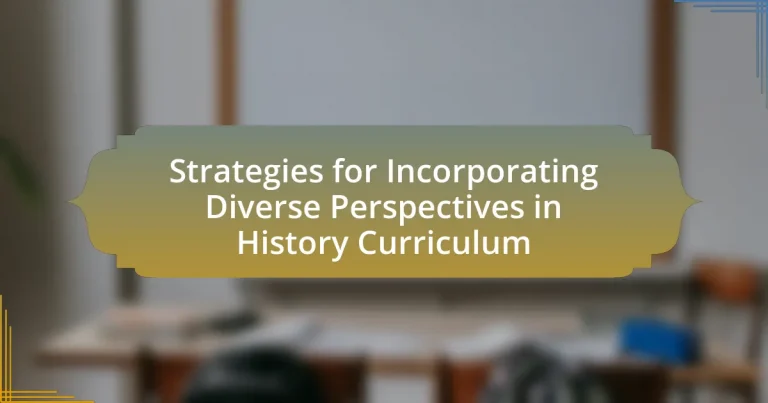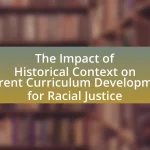The article focuses on strategies for incorporating diverse perspectives in history curriculum, emphasizing the importance of integrating multiple narratives, utilizing primary sources from various cultural backgrounds, and promoting critical thinking through comparative analysis. It outlines methods for educators to identify diverse perspectives, such as analyzing primary and secondary sources, and highlights the role of multimedia resources in presenting underrepresented voices. Additionally, the article discusses the challenges educators may face, including resistance from students and parents, and offers practical tips for enhancing diversity in history education to foster a more inclusive and comprehensive understanding of historical events.
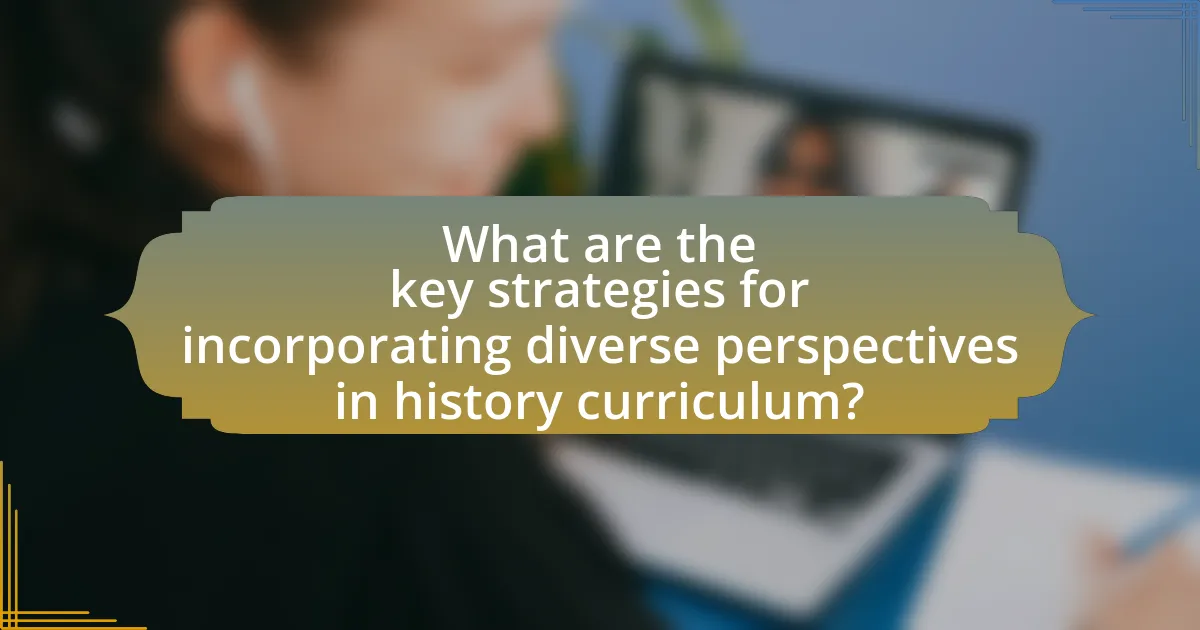
What are the key strategies for incorporating diverse perspectives in history curriculum?
Key strategies for incorporating diverse perspectives in history curriculum include integrating multiple narratives, utilizing primary sources from various cultural backgrounds, and promoting critical thinking through comparative analysis. Integrating multiple narratives allows students to understand historical events from different viewpoints, such as those of marginalized groups, which enriches their comprehension of history. Utilizing primary sources, such as letters, photographs, and artifacts from diverse cultures, provides authentic insights into the experiences of various communities. Promoting critical thinking through comparative analysis encourages students to evaluate and contrast different historical interpretations, fostering a deeper understanding of the complexities of history. These strategies collectively enhance the curriculum by ensuring a more inclusive representation of historical events and figures.
How can educators identify diverse perspectives in historical narratives?
Educators can identify diverse perspectives in historical narratives by analyzing primary and secondary sources from various cultural, social, and political viewpoints. This approach involves examining documents, artifacts, and oral histories that reflect the experiences of marginalized groups, such as women, indigenous peoples, and racial minorities. For instance, the use of texts like “A People’s History of the United States” by Howard Zinn highlights alternative narratives that challenge dominant historical accounts. Additionally, educators can incorporate comparative analyses of historical events to reveal differing interpretations and experiences, thereby fostering a more inclusive understanding of history.
What sources can be used to uncover underrepresented voices in history?
Primary sources such as letters, diaries, oral histories, and photographs can be used to uncover underrepresented voices in history. These sources provide firsthand accounts and personal narratives that often reflect the experiences of marginalized groups. For instance, the Library of Congress hosts a collection of oral histories from various communities, which can reveal insights into their unique historical perspectives. Additionally, academic journals and publications focusing on social history often highlight research that emphasizes the contributions and experiences of underrepresented populations, further enriching the historical narrative.
How do cultural contexts influence historical interpretations?
Cultural contexts significantly influence historical interpretations by shaping the perspectives, values, and narratives that historians and societies prioritize. For instance, the interpretation of events like colonization varies widely; Western narratives often emphasize exploration and economic gain, while Indigenous perspectives highlight displacement and cultural erasure. This divergence illustrates how cultural backgrounds inform the understanding of historical events, leading to different conclusions and lessons drawn from the same occurrences. Furthermore, research shows that incorporating diverse cultural contexts in history education enhances critical thinking and empathy among students, as they learn to appreciate multiple viewpoints and the complexities of historical narratives.
Why is it important to include diverse perspectives in history education?
Including diverse perspectives in history education is crucial because it fosters a more comprehensive understanding of historical events and their impacts. When students learn from multiple viewpoints, they gain insights into the experiences and contributions of various cultures, which enriches their knowledge and promotes critical thinking. Research indicates that curricula incorporating diverse narratives lead to improved engagement and empathy among students, as they recognize the complexity of history beyond a singular narrative. For example, studies show that students exposed to diverse historical perspectives demonstrate greater cultural awareness and are better equipped to navigate a multicultural society.
What impact does diversity in history curriculum have on student engagement?
Diversity in history curriculum significantly enhances student engagement by fostering a more inclusive learning environment. When students encounter multiple perspectives, they are more likely to connect personally with the material, which increases their interest and motivation. Research indicates that curricula incorporating diverse voices lead to higher levels of participation and critical thinking among students. For instance, a study published in the “Journal of Educational Psychology” found that students exposed to a diverse curriculum demonstrated a 20% increase in engagement metrics compared to those with a traditional, less diverse curriculum. This engagement is crucial for developing a deeper understanding of historical events and their relevance to various communities.
How does a diverse curriculum promote critical thinking skills?
A diverse curriculum promotes critical thinking skills by exposing students to multiple perspectives and encouraging them to analyze and evaluate differing viewpoints. This exposure fosters cognitive flexibility, allowing students to question assumptions and develop reasoned arguments. Research indicates that curricula incorporating diverse perspectives enhance students’ ability to engage in reflective thinking and problem-solving, as evidenced by studies showing improved analytical skills in students who learn through varied cultural and historical contexts. For instance, a study published in the Journal of Educational Psychology found that students who participated in a multicultural curriculum demonstrated higher levels of critical thinking compared to those in a traditional curriculum.
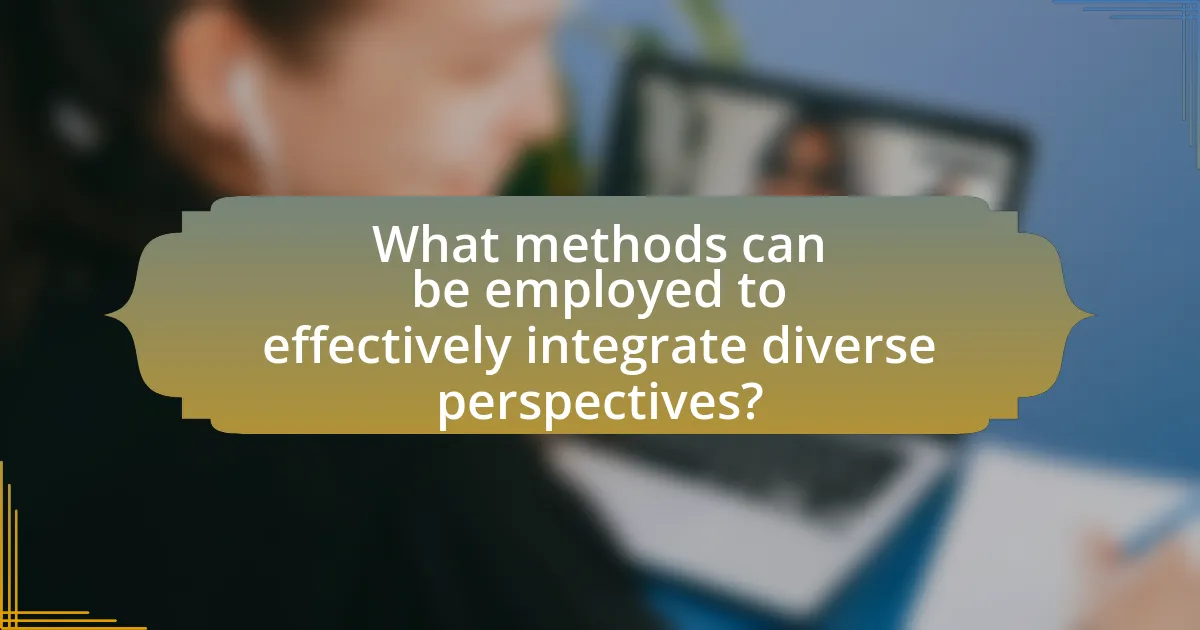
What methods can be employed to effectively integrate diverse perspectives?
To effectively integrate diverse perspectives, educators can employ methods such as collaborative learning, inclusive curriculum design, and critical discourse analysis. Collaborative learning encourages students to work in diverse groups, fostering dialogue and understanding among different viewpoints. Inclusive curriculum design ensures that multiple narratives and voices are represented, allowing students to engage with a broader spectrum of historical experiences. Critical discourse analysis helps students examine the language and power dynamics within historical texts, promoting critical thinking about whose perspectives are included or marginalized. Research indicates that these methods enhance students’ empathy and critical thinking skills, as evidenced by studies showing improved engagement and understanding in classrooms that prioritize diverse perspectives.
How can collaborative learning enhance the incorporation of diverse viewpoints?
Collaborative learning enhances the incorporation of diverse viewpoints by facilitating interaction among individuals with different backgrounds and perspectives. This interaction allows participants to share their unique experiences and insights, leading to a richer understanding of historical events. Research indicates that collaborative learning environments promote critical thinking and empathy, as students engage in discussions that challenge their preconceived notions. For instance, a study by Johnson and Johnson (2014) found that cooperative learning strategies significantly increased students’ ability to appreciate diverse perspectives, thereby fostering a more inclusive learning atmosphere.
What role do group projects play in understanding multiple historical narratives?
Group projects play a crucial role in understanding multiple historical narratives by fostering collaboration and encouraging diverse viewpoints among participants. When students engage in group projects, they are exposed to different interpretations of historical events, which enhances their critical thinking and analytical skills. Research indicates that collaborative learning environments promote deeper engagement with content, as students must articulate their perspectives and consider those of their peers. For instance, a study by Johnson and Johnson (2014) found that cooperative learning strategies, such as group projects, significantly improve students’ ability to understand complex historical contexts by integrating various narratives and perspectives. This collaborative approach not only enriches individual understanding but also cultivates empathy and appreciation for diverse historical experiences.
How can peer discussions foster a deeper understanding of diverse perspectives?
Peer discussions can foster a deeper understanding of diverse perspectives by encouraging participants to articulate and challenge their viewpoints in a collaborative environment. This interaction allows individuals to confront their biases and consider alternative interpretations of historical events, leading to a more nuanced comprehension of complex issues. Research indicates that dialogue among peers enhances critical thinking skills and promotes empathy, as participants are exposed to experiences and insights different from their own. For instance, a study published in the Journal of Educational Psychology found that students engaged in structured peer discussions demonstrated improved understanding of diverse cultural narratives, highlighting the effectiveness of this strategy in educational settings.
What teaching strategies can be utilized to present diverse historical accounts?
Utilizing primary source analysis is an effective teaching strategy to present diverse historical accounts. This approach allows students to engage directly with original documents, artifacts, and testimonies from various perspectives, fostering critical thinking and empathy. For instance, examining letters from different social classes during the American Civil War can reveal contrasting experiences and viewpoints, highlighting the complexity of historical narratives. Additionally, incorporating multimedia resources, such as documentaries and oral histories, can further enrich students’ understanding by showcasing diverse voices and experiences. Research indicates that students who engage with multiple perspectives develop a more nuanced understanding of history, as evidenced by studies conducted by the National Council for the Social Studies, which emphasize the importance of diverse narratives in fostering historical literacy.
How can multimedia resources support diverse perspectives in history lessons?
Multimedia resources can support diverse perspectives in history lessons by providing varied formats such as videos, podcasts, and interactive timelines that present multiple viewpoints on historical events. These resources enable students to engage with different narratives, including those of marginalized groups, thereby fostering a more inclusive understanding of history. For instance, documentaries that feature firsthand accounts from diverse communities can highlight experiences often overlooked in traditional textbooks, such as the perspectives of Indigenous peoples during colonization. This approach not only enriches students’ learning experiences but also encourages critical thinking by prompting them to analyze and compare differing historical interpretations.
What are the benefits of using primary sources from various cultures?
Using primary sources from various cultures enhances historical understanding by providing authentic perspectives and experiences. These sources, such as letters, photographs, and artifacts, allow students to engage directly with the voices and narratives of different cultural groups, fostering empathy and critical thinking. For instance, the use of Native American treaties and oral histories can illuminate the complexities of U.S. history that are often overlooked in mainstream narratives. Additionally, primary sources can challenge stereotypes and promote a more nuanced view of cultural interactions, as evidenced by the diverse accounts of immigrant experiences found in personal diaries and photographs. This approach not only enriches the curriculum but also encourages students to appreciate the multiplicity of historical narratives.
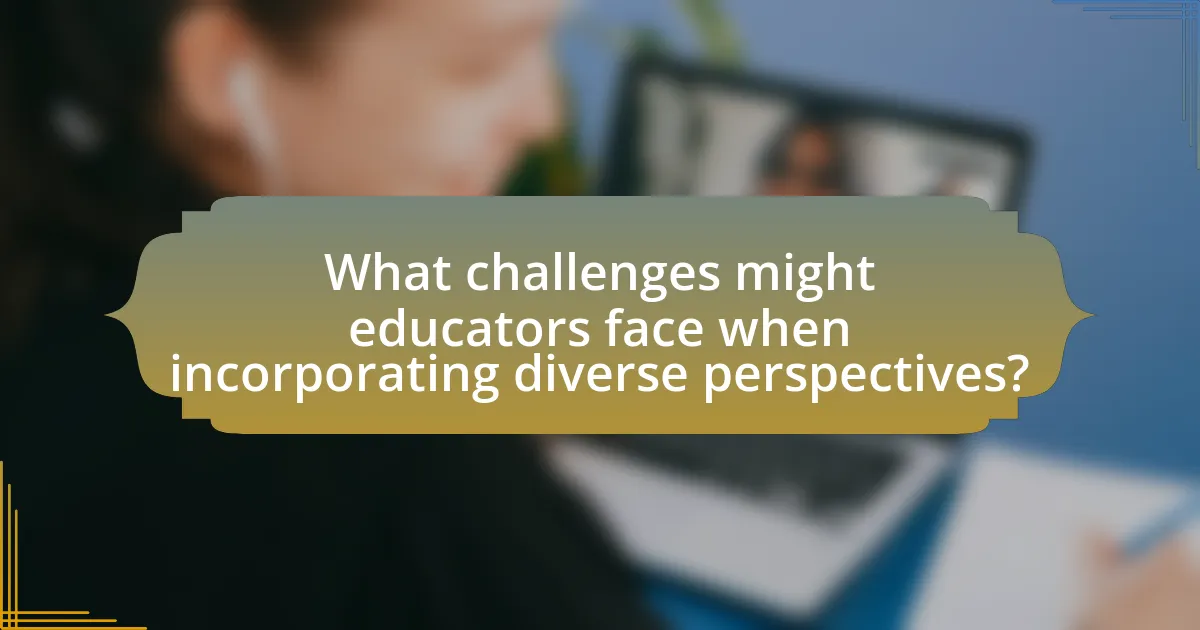
What challenges might educators face when incorporating diverse perspectives?
Educators may face several challenges when incorporating diverse perspectives, including resistance from students and parents, lack of resources, and insufficient training. Resistance can stem from differing beliefs or discomfort with unfamiliar viewpoints, which may hinder open discussions. Additionally, educators often encounter a lack of resources, such as diverse materials and curricula that accurately represent various perspectives, making it difficult to provide a comprehensive education. Furthermore, many educators may not receive adequate training on how to effectively integrate diverse perspectives into their teaching, leading to a lack of confidence in addressing complex topics. These challenges can impede the successful implementation of diverse perspectives in the history curriculum.
How can educators address potential resistance to diverse historical narratives?
Educators can address potential resistance to diverse historical narratives by fostering an inclusive classroom environment that encourages open dialogue and critical thinking. This approach involves implementing strategies such as integrating multiple perspectives into the curriculum, utilizing primary sources from various cultural backgrounds, and facilitating discussions that challenge dominant narratives. Research indicates that when students engage with diverse viewpoints, they develop a more nuanced understanding of history, which can reduce resistance. For instance, a study by the American Educational Research Association found that students exposed to diverse historical narratives demonstrated increased empathy and critical analysis skills, leading to a greater acceptance of differing perspectives.
What strategies can be used to engage skeptical students or parents?
To engage skeptical students or parents, educators can implement strategies such as fostering open dialogue, providing evidence-based resources, and involving them in the learning process. Open dialogue allows for the expression of concerns and questions, creating a safe space for discussion. Evidence-based resources, such as historical documents and scholarly articles, can help validate the curriculum’s content and demonstrate its relevance. Involving students and parents in project-based learning or community events can also enhance their investment in the curriculum, making them active participants rather than passive observers. These strategies have been shown to improve trust and collaboration, as evidenced by studies indicating that parental involvement positively impacts student engagement and achievement.
How can educators navigate curriculum standards while promoting diversity?
Educators can navigate curriculum standards while promoting diversity by integrating diverse perspectives into lesson plans that align with established educational benchmarks. This approach involves selecting materials and resources that reflect a variety of cultural, racial, and historical viewpoints, ensuring that all students see themselves represented in the curriculum. Research indicates that inclusive curricula enhance student engagement and achievement; for example, a study by the National Education Association found that students exposed to diverse perspectives demonstrate improved critical thinking skills and greater empathy. By aligning these diverse materials with curriculum standards, educators can create a more equitable learning environment that meets educational goals while fostering inclusivity.
What are some best practices for evaluating the effectiveness of diverse perspectives in history curriculum?
Best practices for evaluating the effectiveness of diverse perspectives in history curriculum include implementing formative assessments, soliciting student feedback, and analyzing student engagement metrics. Formative assessments, such as reflective essays or group discussions, allow educators to gauge students’ understanding and appreciation of diverse viewpoints. Soliciting feedback through surveys or focus groups helps educators understand how well students connect with the material and identify areas for improvement. Analyzing engagement metrics, such as participation rates in discussions about diverse perspectives, provides quantitative data on the curriculum’s impact. Research indicates that curricula incorporating multiple perspectives enhance critical thinking and empathy among students, supporting the need for these evaluation methods.
How can feedback from students inform curriculum adjustments?
Feedback from students can inform curriculum adjustments by providing insights into their learning experiences and preferences. When students express their thoughts on course content, teaching methods, and assessment strategies, educators can identify areas that require enhancement or modification. For instance, a study by the National Education Association found that student feedback can lead to improved engagement and academic performance when curriculum changes are made based on their input. By analyzing this feedback, educators can tailor the curriculum to better reflect diverse perspectives, ensuring that it resonates with all students and fosters a more inclusive learning environment.
What metrics can be used to assess student understanding of diverse perspectives?
Metrics that can be used to assess student understanding of diverse perspectives include reflective journals, group discussions, and assessments of critical thinking skills. Reflective journals allow students to articulate their thoughts and insights on various perspectives, demonstrating their comprehension and engagement with the material. Group discussions facilitate peer interaction, enabling students to express and challenge differing viewpoints, which can be evaluated through participation and the quality of contributions. Assessments of critical thinking skills, such as essays or projects that require analysis of multiple perspectives, provide measurable evidence of students’ ability to synthesize and evaluate diverse viewpoints. These metrics are supported by educational research indicating that active engagement and critical reflection enhance understanding of complex social issues.
What practical tips can educators implement to enhance diversity in their history curriculum?
Educators can enhance diversity in their history curriculum by integrating multiple perspectives and narratives from various cultural backgrounds. This can be achieved by including primary sources from diverse groups, such as letters, diaries, and oral histories, which provide firsthand accounts of historical events. For example, incorporating the perspectives of Indigenous peoples, women, and minority groups during significant events like the American Revolution or Civil Rights Movement allows students to understand history from a broader viewpoint. Additionally, educators should utilize diverse textbooks and resources that reflect a variety of cultures and experiences, ensuring that students see themselves represented in the curriculum. Research indicates that diverse curricula can improve student engagement and critical thinking skills, as students learn to analyze history through different lenses.
